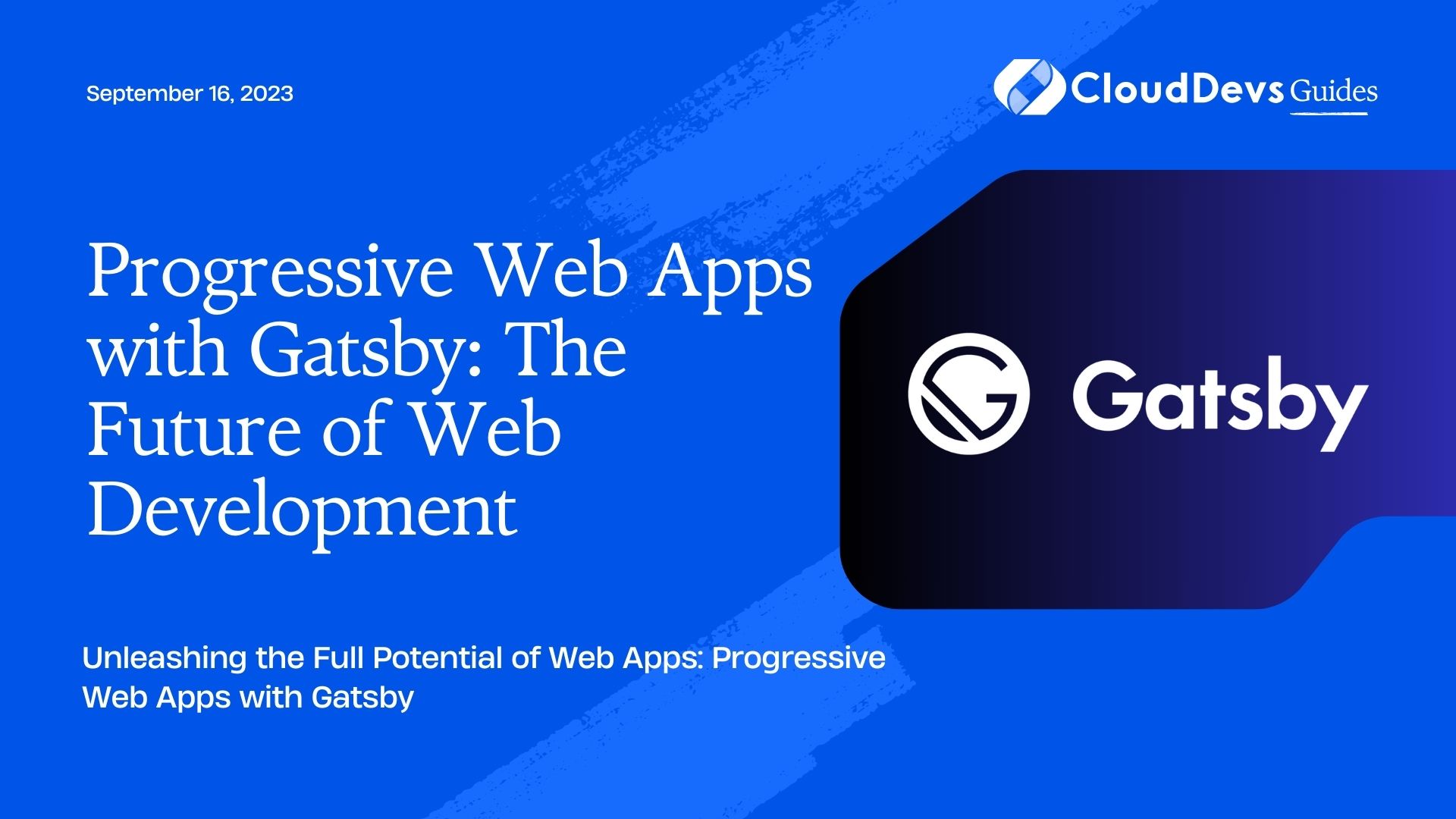Progressive Web Apps with Gatsby: The Future of Web Development
In today’s fast-paced digital world, web developers constantly strive to provide users with seamless, engaging, and reliable experiences. Enter Progressive Web Apps (PWAs) – a revolutionary approach to web development that combines the best of both web and mobile applications. PWAs leverage modern web technologies to deliver native-like experiences, regardless of the device or network conditions. In this blog, we’ll explore how Gatsby, a popular static site generator, plays a crucial role in shaping the future of web development by enabling the creation of powerful Progressive Web Apps.
What are Progressive Web Apps (PWAs)?
Progressive Web Apps are web applications that provide a native app-like experience to users while being accessible through a web browser. They aim to bridge the gap between traditional websites and mobile applications, offering enhanced performance, offline capabilities, and improved user engagement. PWAs can be installed on users’ devices and function independently of an internet connection, making them reliable and responsive.
The Key Features of Progressive Web Apps:
- Responsive Design: PWAs adapt seamlessly to various screen sizes, ensuring a consistent and user-friendly experience across different devices, including desktops, tablets, and smartphones.
- Offline Support: One of the most significant advantages of PWAs is their ability to work offline or with a limited internet connection. This feature is achieved by caching critical assets, allowing users to access content even when they are not connected to the internet.
- Fast Loading Times: PWAs are designed to load quickly, reducing bounce rates and keeping users engaged. Their optimized performance stems from various techniques such as lazy loading and efficient resource caching.
- App-like Interactions: PWAs provide smooth and fluid interactions, similar to native mobile applications. This makes the user experience more immersive and enjoyable.
- Secure Connections: PWAs are served over HTTPS, ensuring data privacy and security for users, which is crucial for modern web applications.
- Discoverability and Shareability: PWAs can be easily shared via URLs, and they support features like deep linking, allowing users to find specific content within the app and share it with others.
Why Gatsby for Progressive Web Apps?
Gatsby is a powerful and flexible static site generator built on top of React. It has gained significant popularity in the web development community due to its ability to create high-performance websites and applications. Here’s why Gatsby is the perfect choice for building Progressive Web Apps:
1. Blazing Fast Performance:
Gatsby follows the concept of the JAMstack (JavaScript, APIs, and Markup), where sites are generated statically and served via Content Delivery Networks (CDNs). This architecture drastically improves website performance, resulting in faster load times and reduced server response times. With Gatsby’s efficient data handling and image optimization, building a performant Progressive Web App becomes effortless.
Code Sample:
javascript
// Sample Gatsby GraphQL query to fetch data
import { graphql } from 'gatsby';
export const query = graphql`
query HomePageQuery {
allPosts {
nodes {
title
content
}
}
}
`;
2. Progressive Image Loading:
Gatsby employs a technique called “lazy loading” to load images progressively. This means that images are only loaded when they come into the viewport, reducing initial loading times significantly. As a result, PWAs built with Gatsby offer a smoother user experience, especially on devices with slower internet connections.
Building Your First PWA with Gatsby
1. Setting up a Gatsby Project:
To get started with building a Progressive Web App using Gatsby, make sure you have Node.js installed on your system. Then, create a new Gatsby project using the Gatsby CLI:
bash npx gatsby new my-pwa-project cd my-pwa-project
2. Configuring Gatsby Plugins for PWA:
Gatsby provides various plugins to enhance your web app’s capabilities. To enable PWA features, you can use the gatsby-plugin-manifest and gatsby-plugin-offline plugins. The gatsby-plugin-manifest generates a web app manifest file that defines how your PWA appears on users’ home screens. The gatsby-plugin-offline ensures your app can function even when users are offline.
Code Sample – gatsby-config.js:
javascript
module.exports = {
plugins: [
'gatsby-plugin-manifest',
'gatsby-plugin-offline',
],
};
3. Implementing Offline Support:
With the gatsby-plugin-offline, your app can cache critical resources and serve them when users are offline. This allows for a consistent user experience regardless of network conditions. You can also define fallback strategies for specific URLs or assets to customize the offline behavior of your app.
Code Sample – gatsby-config.js:
javascript
module.exports = {
plugins: [
{
resolve: 'gatsby-plugin-offline',
options: {
// Configure caching strategies here (if needed)
},
},
],
};
4. Generating a Web App Manifest:
The web app manifest file is essential for PWAs, as it provides information about the app, such as its name, icons, and splash screens. Users can add your PWA to their home screens using the details from this manifest file. You can configure the gatsby-plugin-manifest with relevant details for your app.
Code Sample – gatsby-config.js:
javascript
module.exports = {
plugins: [
{
resolve: 'gatsby-plugin-manifest',
options: {
name: 'My Progressive Web App',
short_name: 'MyPWA',
start_url: '/',
background_color: '#ffffff',
theme_color: '#663399',
display: 'standalone',
icon: 'src/images/icon.png',
},
},
],
};
5. Optimizing Images for Performance:
As mentioned earlier, image optimization is crucial for creating a fast-loading PWA. Gatsby’s image processing capabilities allow you to transform and optimize images to different sizes and formats based on the user’s device, resulting in improved performance and reduced data usage.
Code Sample – gatsby-config.js:
javascript
module.exports = {
plugins: [
{
resolve: 'gatsby-plugin-sharp',
options: {
// Configure image optimization options here
},
},
],
};
Conclusion
Progressive Web Apps with Gatsby represent the future of web development, offering a seamless and engaging user experience on the web. Combining Gatsby’s speed, flexibility, and rich plugin ecosystem with the power of PWAs opens up new possibilities for developers to create high-performing applications that work offline, load quickly, and provide app-like interactions.
As more users demand fast and reliable web experiences, embracing Progressive Web Apps and leveraging the potential of Gatsby will undoubtedly become the norm for web development in the coming years. So, get started with Gatsby and start building the future of web applications today!
Table of Contents







